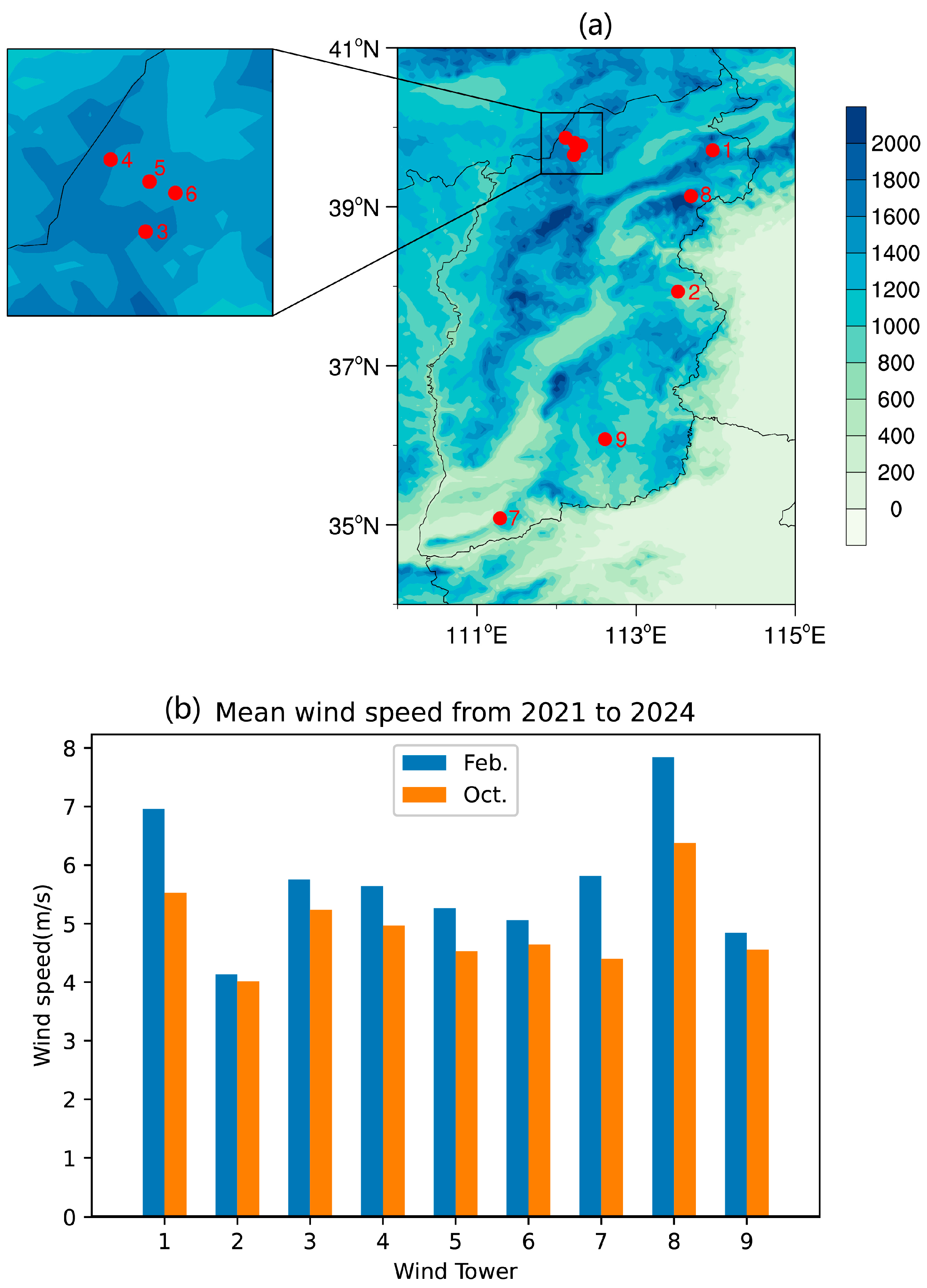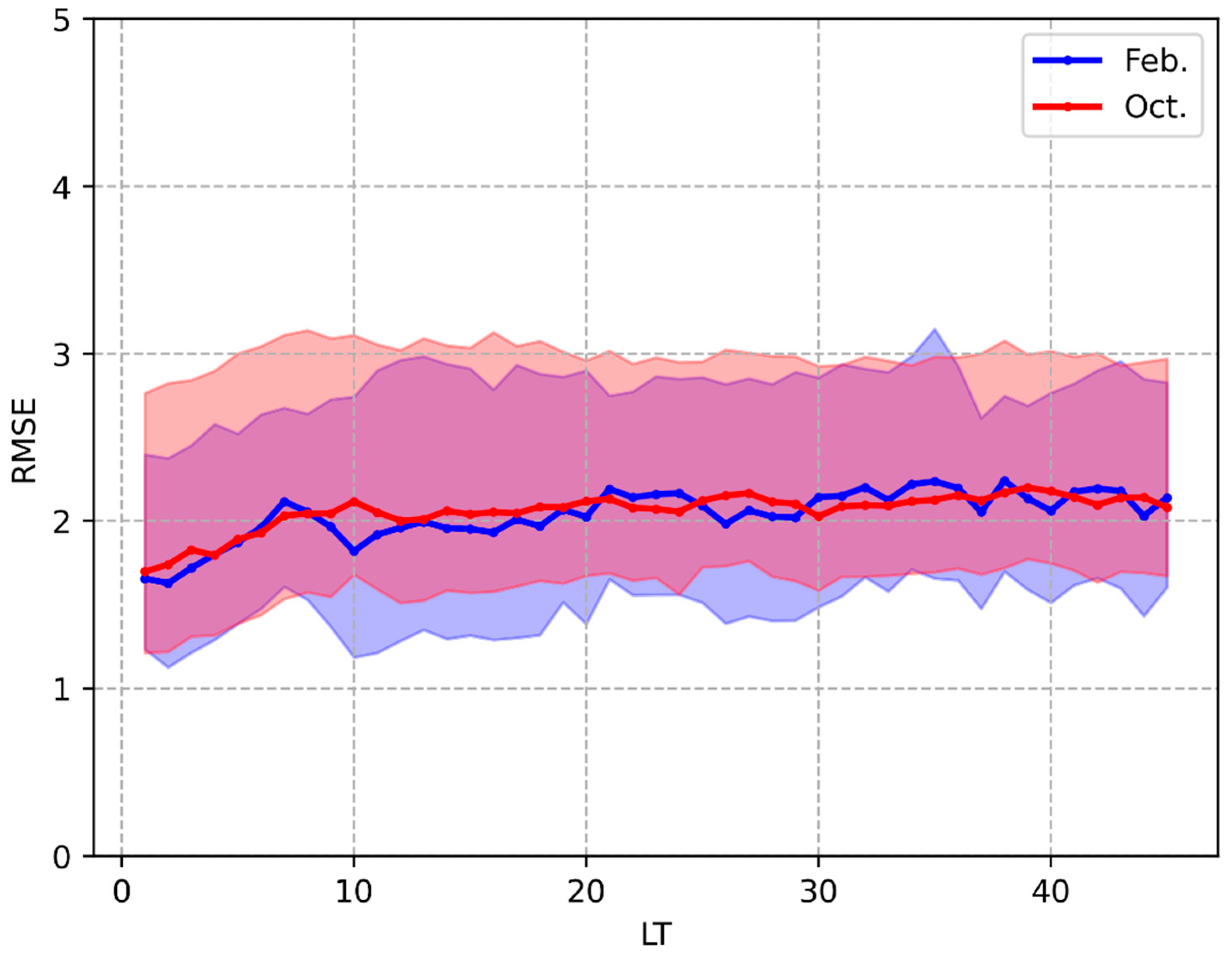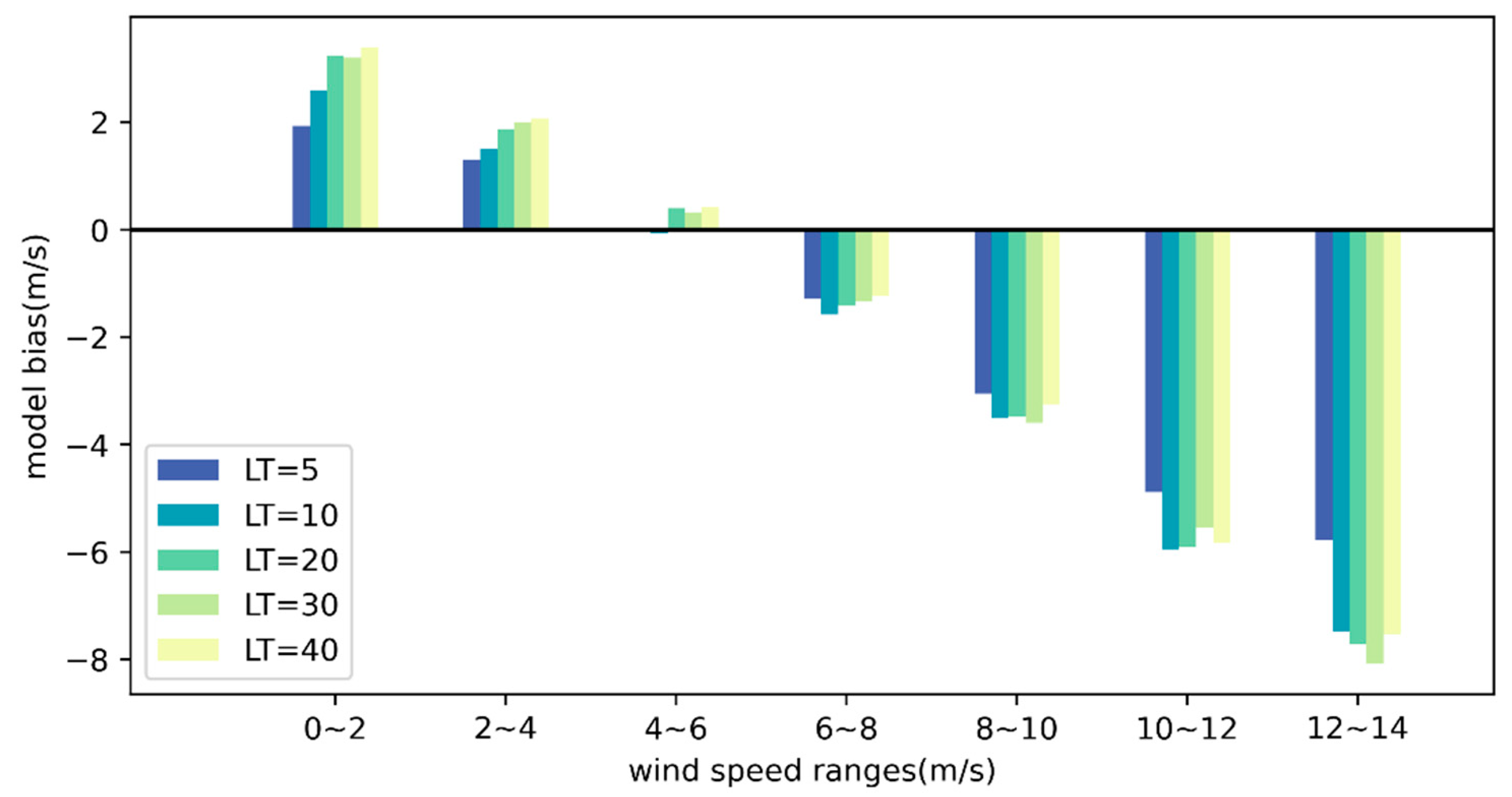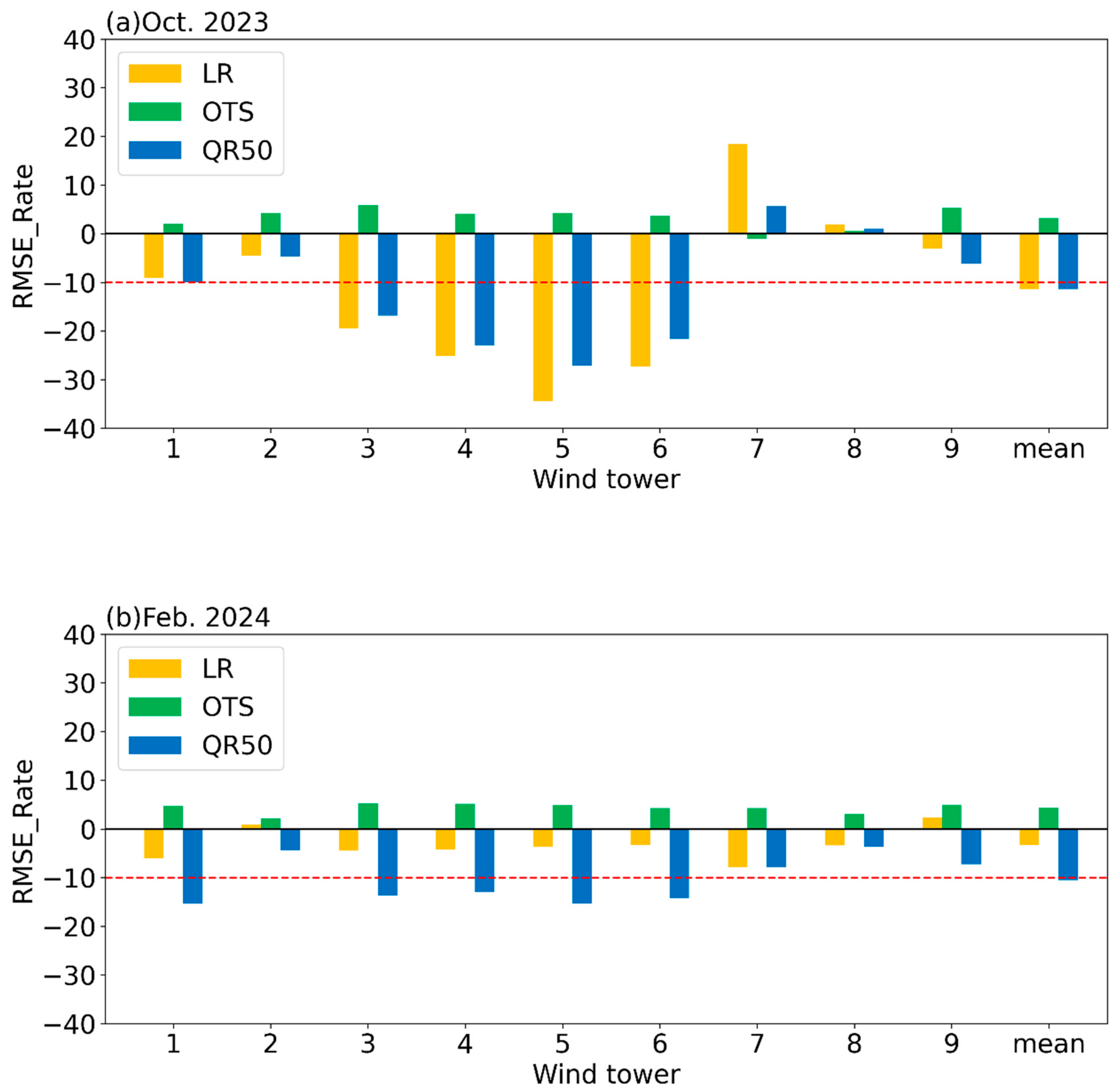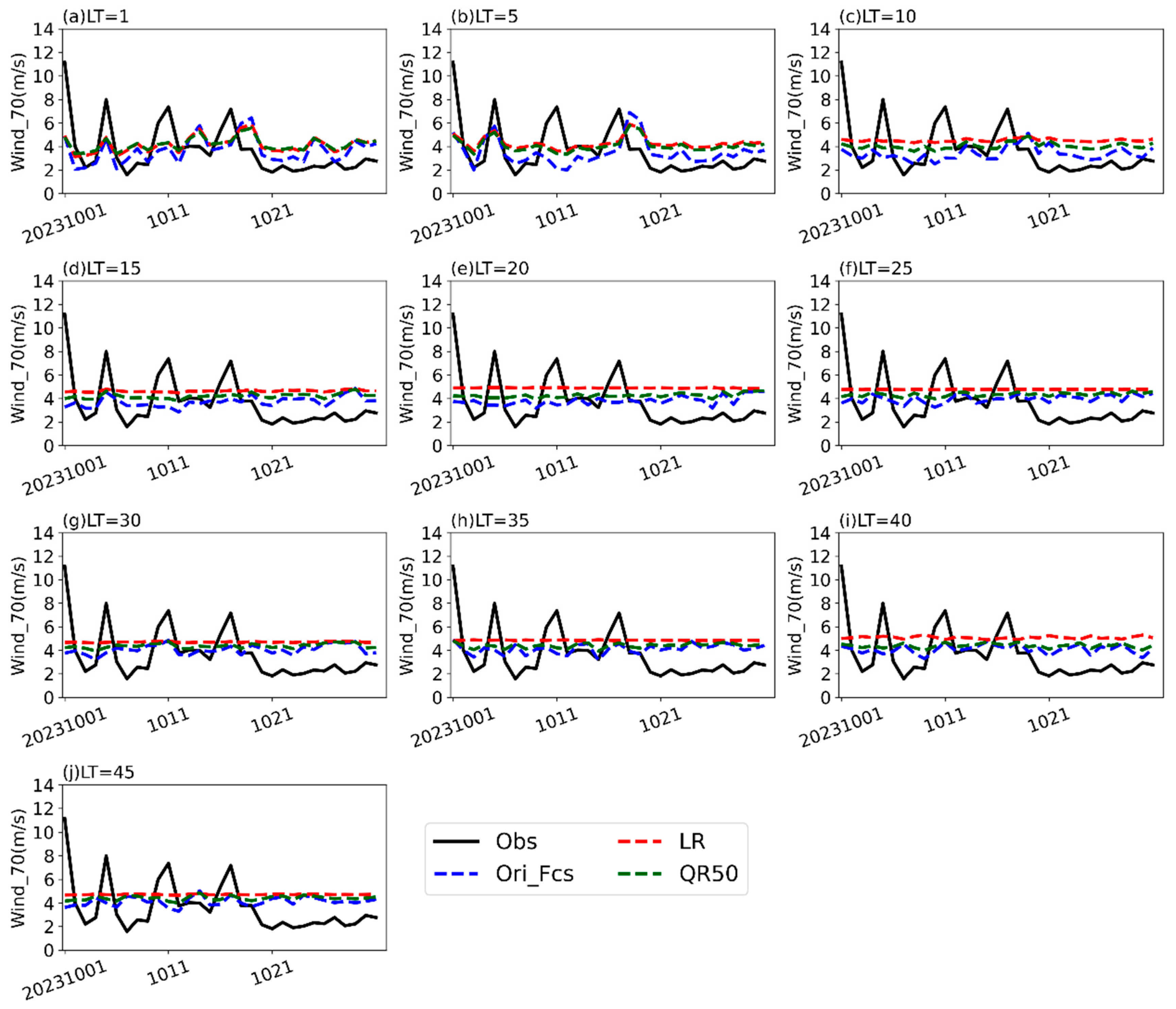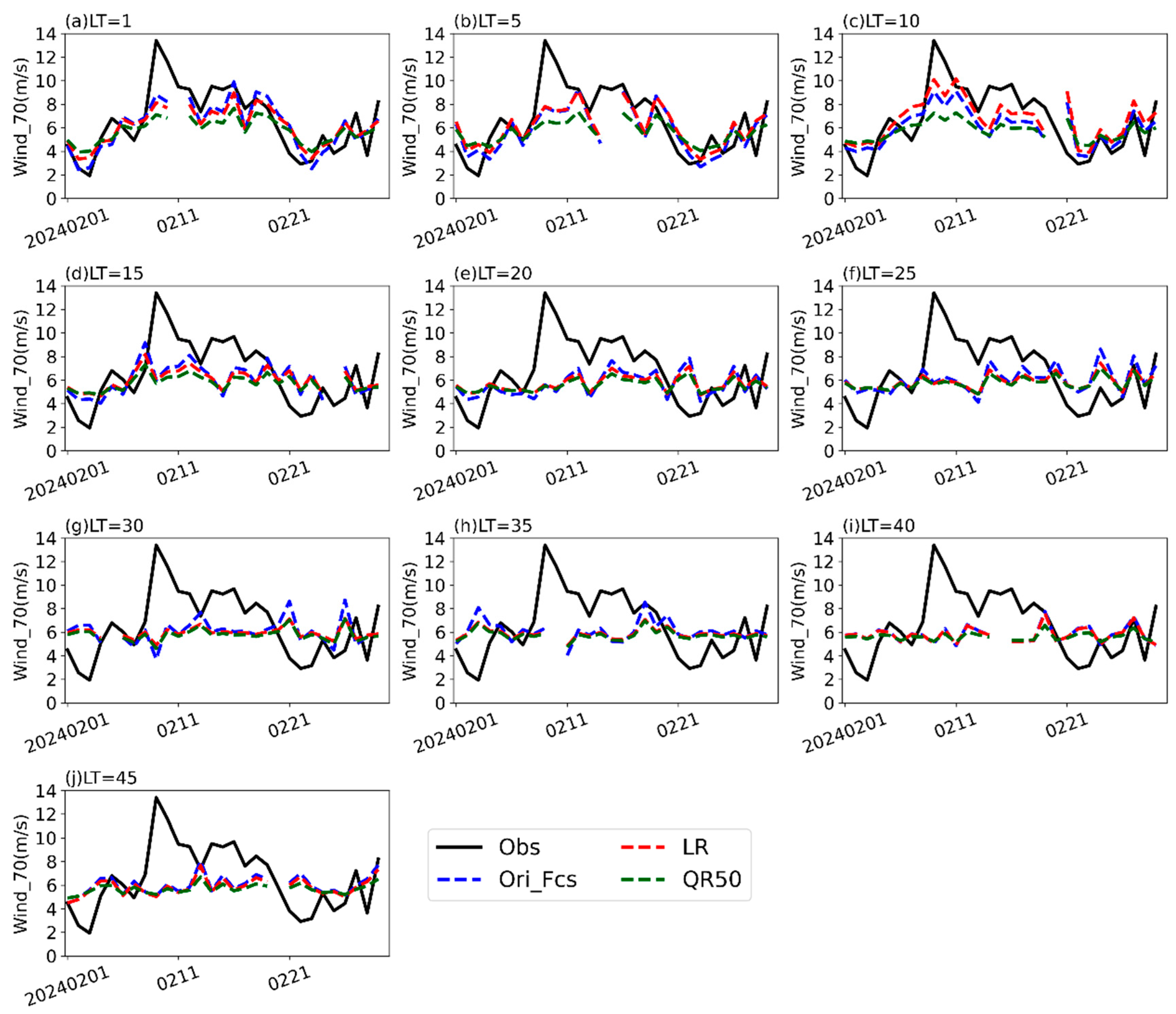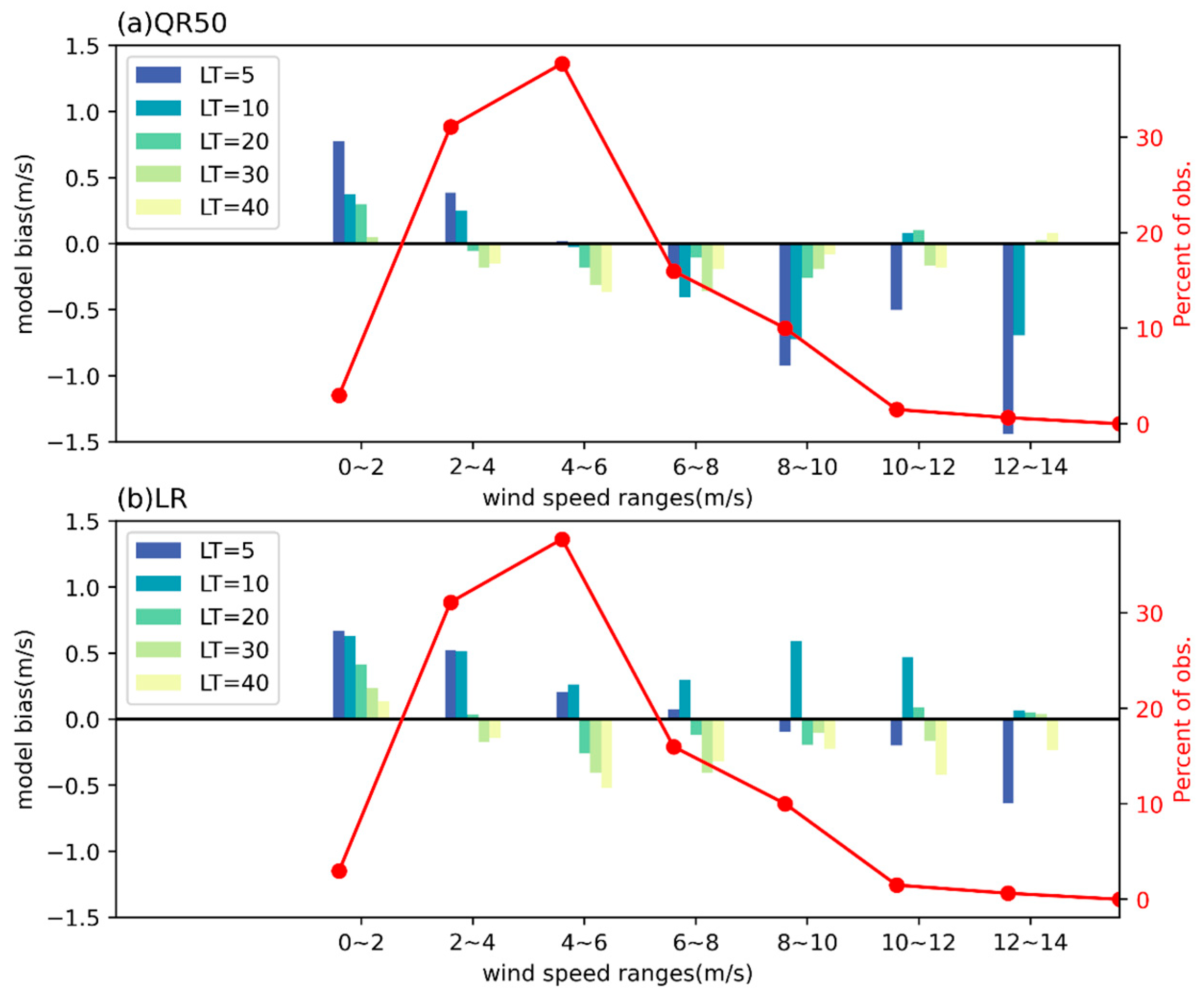1. Introduction
Shanxi Province, located in northern China, has emerged as a pivotal region for wind energy development due to its abundant wind resources and strategic policy frameworks [
1]. The province’s wind energy potential is characterized by an average wind power density of grade 2 or higher across most planned wind farm areas, with annual effective wind speed hours exceeding 6000 h at heights of 70 m [
2].
Accurate near-surface wind speed prediction is vital for renewable energy management [
3]. Climate models play a crucial role in wind speed prediction, especially in addressing and forecasting climate change and its long-term impacts on wind speed [
4]. These predictions are also crucial for industries such as agriculture, shipping, construction, and particularly for wind energy development [
5]. For the wind power industry, climate models can help optimize the placement of wind turbines, enhancing the energy efficiency and economic benefits of wind farms [
6]. Recent advances in models, known as the quiet revolution, have been characterized by continuous improvements in data assimilation, ensemble forecasting, and high-resolution modeling, rather than singular breakthroughs [
7]. Numerical weather prediction (NWP) is also undergoing a paradigm shift due to the rapid integration of machine learning (ML), which now outperforms traditional physics-based models in operational forecasts [
8]. Despite advancements in climate models, persistent biases in wind speed forecasts remain a significant challenge, primarily stemming from inaccuracies in initial field data, coarse model resolution, and incomplete representation of sub-grid-scale physical processes [
9,
10].These systematic errors compromise the reliability of wind energy predictions, particularly in topographically complex regions, necessitating targeted bias-correction techniques to improve forecast utility for renewable energy applications [
11].
Bias correction methods are recognized as an efficacious approach for reducing errors in model predictions, and these techniques systematically adjust the original outputs of the models to enhance the accuracy of forecasts [
12,
13]. The Climate Forecast System Version 2, developed by the National Centers for Environmental Prediction (NCEP CFSv2) [
14], which is widely used, exhibits significant errors in 70 m wind speed forecasts [
15], including overestimation of low wind speeds and underestimation of high wind speeds. Such biases limit its utility for wind energy applications, necessitating robust post-processing techniques.
Previous studies have primarily focused on correcting nowcasting predictions (less than 10 days ahead), while research on the applicability of different correction methods to sub-seasonal scales remains notably lacking. This study tries to address these gaps by evaluating three bias correction methods to CFSv2 forecasts in Shanxi. Using high-resolution observational data from nine wind towers (2021–2024), we quantify model biases and assess correction efficacy under different wind speed thresholds and lead times (LTs) extending to 45 days.
This work aims to enhance operational forecasting accuracy and provide insights into the limitations of uniform correction approaches in heterogeneous environments. We select February and October for evaluation, for these two months are the crucial transitional months when the maximum wind speed changes from small to large (or from large to small) [
16]. Furthermore, the wind speed variation in these two months has a significant impact on the scheduling and planning of wind power enterprises, but the wind prediction accuracy is lower than other months. Hence, this work mainly focuses on the wind speed prediction correction for these two months, hoping to solve practical problems for wind power enterprises. The data and methods used in this work are introduced in
Section 2.
Section 3 shows the application effects of the above three methods utilized. A summary and discussion are provided in
Section 4.
3. Results
The model bias in February 2022/2023 and October 2021/2022 is shown in
Figure 2 and
Figure 3.
Figure 2 shows the mean RMSE of 70 m wind speed of nine wind towers from 1 to 45 days in advance. The RMSEs of the two months are roughly equivalent, and the variability in February is greater. When the lead time (LT) is less than 7 days, the RMSE increases significantly as the LT increases. For an LT of less than 7 days, the RMSE remains below 2.25 m/s. Subsequently, as the LT extends further, the RMSE fluctuates around an average level above 2.1 m/s. Overall, during the extended forecast period (1 to 45 days in advance), the RMSE of wind speed forecasts exceeds 1.5 m/s, indicating substantial room for improvement in the forecasting performance of the model.
Figure 3 illustrates the average bias of different 70 m wind speed ranges. When the observed 70 m wind speeds are below 6 m/s, the positive model bias occurs in the first three bins. For observed 70 m wind speeds above 6 m/s, a negative model bias is presented, which significantly increases as the wind speed and forecast LT increase. At an LT of 1 day, the model bias for observed wind speeds of 6–8 m/s is −1.5 m/s, and for wind speeds of 12–14 m/s, the average bias is −5.6 m/s. When the LT extends to 30 days, the model bias remains at −1.6 m/s with observed wind speeds of 6–8 m/s, but the bias for wind speeds of 12–14 m/s reaches −7.7 m/s. It is implied that the model demonstrates a distinct bias characteristic for 70 m wind speed forecasts, with underestimation for higher wind speeds and overestimation for lower wind speeds, which is similar to a previous study [
21].
For the low prediction skill of the model for 70 m wind speed (
Figure 2), and based on the characteristics of model bias within different wind speed ranges (
Figure 3), three bias correction methods are selected to attempt to reduce model bias and improve the prediction accuracy of wind speed.
To evaluate the overall bias levels under different correction methods, the RMSE of the original model forecast is calculated for the test periods (October 2023 and February 2024). The corresponding RMSEs before and after correction are shown in
Figure 4 and summarized in
Table 1. After applying three different correction methods, the results indicate that the OTS method does not effectively reduce forecast bias, suggesting that a uniform correction coefficient based on different thresholds is not suitable in cases where there is significant bias variability across wind towers. In contrast, the other two correction methods successfully reduce the model bias at all wind towers, except for wind towers 7 and 8 in October 2023, demonstrating the robustness of using historical data for regression-based forecast corrections, particularly at wind towers with high original RMSE. The QR50 method is notably effective in the two test periods.
Wind tower 9, which has the lowest RMSE among all the wind towers, also shows a significant reduction (more than a 6% reduction in model bias across both periods) of mean RMSE with the QR50 method. From an average perspective across all the wind towers, during October 2023 (February 2024), the QR50 method reduces the original RMSE from 1.52 (2.35) to 1.36 (2.11) as in
Table 1, a decrease of 11% (10%), passing the 95% student-t significant test.
Figure 5 presents the growth rate of the RMSE (RMSE_rate, defined as the difference between the RMSE after correction and before correction, divided by the RMSE before correction) for the three correction methods. The mean RMSE_Rate of the three methods is −3.28%, 4.33%, and −10.50%, respectively, in October 2023 (
Figure 5a) and −11.38%, 3.21%, and −11.40%, respectively, in February 2024 (
Figure 5b). Overall, the OTS method has an opposite correction effect, which can increase the RMSE by approximately 5% (green bars in
Figure 5). In October 2023, the LR method effectively reduced the RMSE across all stations except for wind towers 7 and 8. Notably, the reduction exceeded 10% at wind towers 3, 4, 5, and 6, with the most significant improvement observed at wind tower 5, where the reduction surpassed 30% (yellow bars in
Figure 5a). The QR50 method demonstrated a reduction in the RMSE across all stations except for wind towers 8 and 9. However, the magnitude of reduction was generally smaller compared to the LR method. Notably, at wind towers 3, 4, 5, and 6, the reduction exceeded 10%, with wind tower 5 showing the most significant improvement, where the reduction surpassed 25% (blue bars in
Figure 5a). The reduction in the RMSE achieved by both the LR and QR50 methods is less significant in February 2024 (
Figure 5b) compared to October 2023 (
Figure 5a). Only the QR50 method achieved a reduction in the RMSE exceeding 10% at wind towers 1, 3, 4, 5, and 6 (blue bars in
Figure 5b). When the RMSE values are higher (with the February 2024 RMSE generally exceeding 2 in
Figure 4b), the QR50 method demonstrates a more stable correction performance compared to the LR method.
Next, we conducted a comparative analysis of the performance of QR50 and LR methods across various LTs in
Figure 6. In October 2023 (
Figure 6a), both the LR and QR50 methods reduced the RMSE in varying degrees across all LTs except for short LTs (1–4 days). At longer LTs, the magnitude of RMSE reduction increased significantly, while the two methods exhibited comparable performance. In February 2024 (
Figure 6b), both correction methods failed to reduce the RMSE across LTs of 1–9 days. They slightly increased the RMSE at 5-day and 9-day LTs. When the LT exceeded 10 days, both methods effectively reduced the RMSE, and the magnitude of reduction shows a slight increase as the LT extended further. The QR50 method consistently demonstrates superior RMSE reduction compared to the LR method, particularly under conditions of higher RMSE values. For instance, at a 17-day LT, the LR method shows a minimal reduction in the RMSE, while the QR50 method achieves substantial RMSE reduction. The analysis reveals that the correction methods primarily reduce the RMSE at LTs exceeding 10 days. Furthermore, the correction effectiveness improves as the LT increases. Notably, under conditions of higher RMSE, the QR50 method demonstrates a more stable correction performance compared to the LR method.
To further investigate the reasons behind the varying correction performance of different methods across wind towers, we selected wind tower 5 (
Figure 7), which demonstrated the best correction performance in October 2023, and wind tower 7 (
Figure 8), which exhibited the poorest correction performance, for detailed analysis.
In October 2023, the daily wind speeds at wind tower 5 exhibited minor fluctuations around 4 m/s, as indicated by the black solid line in
Figure 7. At an LT of 1 day, the raw CFSv2 predictions effectively capture the characteristics of daily wind speed variations. Both correction methods show minimal differences compared to the raw model output for most periods. However, slight adjustments are observed under specific conditions: the methods correct lower wind speeds upward (e.g., around 2 m/s on October 10) and higher wind speeds downward (e.g., around 8 m/s on October 31). Consequently, the overall RMSE remains largely unchanged, as illustrated in
Figure 6a. At an LT of 5 days, the CFSv2 model continues to capture the intra-monthly variation characteristics of wind speed. However, it significantly underestimates the wind speeds during the early and mid-to-late periods of the month, exhibiting a tendency to overestimate low wind speeds and underestimate high wind speeds. Both the QR50 and LR methods demonstrate effective correction capabilities under these conditions.
In October 2023, four high-wind events were recorded at wind tower 7 compared to wind tower 5, with daily average wind speeds exceeding 11, 8, 7, and 7 m/s, respectively (black lines in
Figure 8). The original forecasts from the CFSv2 model demonstrate relatively accurate capture of the first two high-wind events at an LT of less than 10 days. However, for the third and fourth high-wind events, the predictions exhibit a lag of approximately 2 days (blue lines in
Figure 8). After October 20th, the observed wind speed fluctuated at around 2 m/s, while the wind speed predicted by CFSv2 exhibits a systematic positive bias, consistently overestimating the actual values. At an LT greater than 10 days, the model predicted wind speed exhibits minimal intra-monthly variability, remaining consistently around 4 m/s. This suggests a significant loss of predictive skill in capturing temporal wind speed fluctuations at extended forecast ranges, highlighting a limitation in the model’s ability to resolve small-scale atmospheric dynamics over longer LTs. The QR50 and LR methods exhibit a tendency to adjust wind speeds upward, which demonstrates a positive correction effect during several high-wind events. However, during intermittent periods of high winds, particularly in late October, this correction leads to an increase in the RMSE.
Next, we analyzed two wind towers with contrasting correction performance in February 2024: wind tower 1 (
Figure 9), which demonstrates relatively effective correction results, and wind tower 8 (
Figure 10), which exhibits comparatively poor correction performance. This comparative analysis aims to identify the factors contributing to the differential effectiveness of the correction methods and to explore potential improvements in forecasting accuracy.
For wind tower 1, the wind speed in February exhibits a trend of initially increasing and subsequently decreasing (black lines in
Figure 9). At an LT of less than 15 days, the CFSv2 model demonstrates a relatively good ability to capture the intra-monthly variations in wind speed, particularly for the two high-wind events around the 11th and 15th, with wind speeds approaching 10 m/s (
Figure 9a–d). However, the model significantly overestimates wind speeds around the 8th and 18th. Both the QR50 and LR methods slightly reduce the overestimated wind speeds, thereby decreasing the RMSE. At an LT greater than 15 days, the CFSv2 model largely fails to capture the intra-monthly variations in wind speed, resulting in overestimated wind speeds in the first 10-day period, underestimated wind speeds in the middle 10-day period, and overestimated wind speeds again in the last 10-day period. The QR50 and LR methods primarily adjust the predicted wind speeds downward in the first 10-day period and last 10-day period, thereby reducing the overall RMSE.
For February 2024, the wind speed at wind tower 8 exhibits a trend of initially increasing, then decreasing, followed by fluctuations toward the end of the month (black lines in
Figure 10). At an LT of less than 15 days, the CFSv2 generally captures the intra-monthly variations in wind speed. However, it significantly underestimates the magnitude of the extreme high-wind event on the 9th, with observed wind speeds exceeding 13 m/s but predicted speeds reaching only 8 m/s (
Figure 10a–d). Due to the absence of similar cases in the training period during February, both the QR50 and LR methods adjust wind speeds downward during the high-wind event, resulting in an increase in the RMSE. At an LT greater than 15 days, the CFSv2 model overestimates wind speeds from the 1st to the 3rd, underestimates wind speeds from the 8th to the 18th, and overestimates wind speeds from the 19th to the 22nd (
Figure 10e–j). Influenced by the extreme wind speeds, neither correction method is able to effectively adjust the wind speeds, leading to a relatively large RMSE during this period.
The differences of bias between post-corrected and before-corrected results in different wind speed bins are presented in
Figure 11. From the figure, we can see that our correction method works mainly when the LT is large, consistent with the final results. What is more, the correction can reduce ‘smaller wind speeds’ mainly from 2 m/s to 8 m/s, but it performs poorly for larger wind speeds except for LR at LT = 10. The probability density distribution of wind speeds (red lines on the right
y-axis) shows that the wind speeds are mainly distributed in the range of 2–8 m/s (each interval is more than 10%), and the improvement in our correction method for the wind speeds in the main wind speed distribution intervals leads to the final results.
4. Summary and Discussion
This study evaluates the prediction performance of the CFSv2 model for wind speeds at a height of 70 m at nine wind towers in Shanxi Province during February and October. The results indicate that the CFSv2 model consistently overestimates low wind speeds (<6 m/s) and underestimates high wind speeds (>6 m/s), with RMSE exceeding 1.5 m/s. Biases amplify with LT increases, reaching −7.7 m/s for 12–14 m/s winds at 30-day LTs.
To improve the model performance, three correction schemes were tested to correct the 70 m wind speed simulations. QR50 outperformed the other methods, reducing the mean RMSE by ~10% in both test periods. Its robustness stems from addressing conditional distribution biases, particularly at longer LTs (>10 days). LR showed significant improvements in October 2023 but less stability in February 2024, suggesting sensitivity to seasonal variability. OTS increased the RMSE by ~5%, failing to account for spatial heterogeneity across wind towers. QR50′s effectiveness supports its integration into operational forecasting systems, especially for extended LTs. These findings highlight the potential of statistical correction methods, especially QR50, in enhancing the accuracy of wind speed forecasts under varying meteorological conditions.
The reduction in the RMSE by the QR50 and LR methods is primarily observed at LTs greater than 10 days, with minimal impact on the RMSE at LTs of less than 10 days. This is largely attributed to the model’s relatively accurate prediction of intra-monthly wind speed variations at LTs of less than 10 days, particularly its ability to capture high-wind events, albeit with insufficient magnitude. In contrast, at LTs greater than 10 days, the model’s predicted intra-monthly wind speed variations exhibit reduced amplitude, allowing the correction methods to amplify or reduce wind speeds based on historical data, thereby better capturing the observed wind speed variations. When intra-monthly wind speed variations are relatively small, the correction methods demonstrate a more pronounced reduction in the RMSE. However, during periods with high-wind events, the lack of corresponding historical records for such extreme conditions leads to poorer correction performance. This underscores the importance of historical data representativeness and the challenges in correcting forecasts for rare or extreme meteorological events. Extreme wind events (e.g., >13 m/s at wind tower 8) highlight the limitations of regression methods when historical training data lacks analogous cases.
Due to the relatively short observation period in the wind towers, we modeled for different months and different LTs, with no distinction between wind towers, leading to incomplete consideration of the characteristics of different wind towers as well as a few extremely high-wind events which were observed and therefore included in the correction methods. Thus, future work should explore hybrid methods combining QR50 with machine learning to address extreme events and improve temporal resolution [
22]. Additionally, expanding training datasets to include diverse meteorological conditions could enhance model generalizability. Moreover, factors such as the topography and environmental conditions surrounding each anemometer tower should be considered in the development of tailored correction approaches [
23]. These considerations are critical for improving the adaptability and precision of correction methods across diverse geographical and meteorological contexts.
